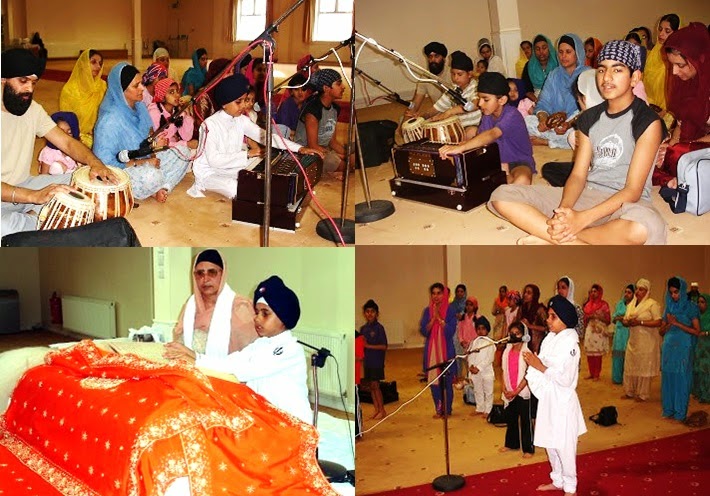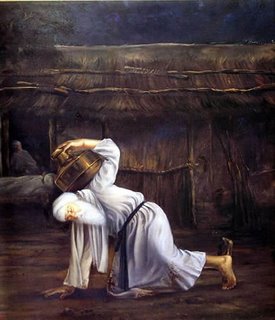Continued from
Part 1...
The
next week they had driven a long way to reach another camp to be on
time to be included among those receiving Amrit. Something profound had
happened and her life had begun to change.
But she made
mistakes. Right away she couldn't stop removing hair from her face.
Little by little in stages she had first let her eyebrows grow in, then
hairs came in under her chin. Surely there were many more than had ever
been there before. Lastly she got the courage to let the hair above her
lip grow. It wasn't easy. The morning after Keertan Smaagam, she had
pulled out every one with her fingers. While driving home from the
Rainsbayee, something had happened there as they sang the last Shabad.
Something like when she took Amrit, yet still, she pulled out every
hair.
She wept into the rumaalas (the draperies
covering Sri Guru Granth Sahib ji), begging Guru ji to forgive her and
help her have courage. She sat with her fists clenched into tight balls,
sitting on her hands, while something like a cactus patch, sprouted on
her face. Then she went before Guru-Roop Panj Pyaare once more and
confessed her mistakes.
Still she wasn't happy, she
looked so disfigured, and the bleach didn't help, instead it just made
her appear more bizarre. How could she try to hide something from the
world, and yet show that she was a Sikh at the same time? She felt so
ugly, how could anyone love her, how could she love herself? Her best
friend told her "You look good! You look like a Singhni," and
that helped a little. But it wasn't anything she could talk about to any
one, only Guru ji, and to Guru ji she wept copiously, wetting the
rumaalas with her tears.
She made up her mind to stop
with the bleach. The make-up aswell, as it just made her feel dirty and
ashamed. She went to the store and tried on a bathing suit. The top
looked really attractive, but her Kachhera come out from underneath the
bottom part, and then she saw her face. It just didn't match. She never
wore that kind of suit for bathing again. Sometimes she felt proud when
she secretly noticed other ladies sitting on the stage who looked like
they had bleached their facial-hair.

Then
one day she had an attack of nerves and started pulling at her
whiskers. Yes, that's what they were, rough and coarse whiskers. In
better moments, she remembered that kittens have whiskers, and that
every one loves kittens. Even, she saw a lady horse once that had long
whiskers, and everyone petted her affectionately. But this day, she
couldn't help herself and pulled out whisker after whisker. O there were
plenty left. Just a few around the edges were missing, no one else
would ever know. And they would grow back!!! No doubt about that, they
had always grown back. She even went to doctor, and he told her they
could only be removed surgically. They always would grow back otherwise.
Sometimes
they got wet when she drank, she shuddered. Just like a man’s. But she
couldn't complain because after all men had so many more, and much
longer. Sometimes, every once in a while it made her feel like a smaller
version of a Singh, but more often she looked at the smooth, beautiful,
glowing, radiant faces of other women and wept inside with shame. When
she looked in the mirror, sometimes she felt like she was looking at
Guru Sahib’s face. So she could not protest, yet still she wept.
Then
one day her beloved brother was in an industrial accident at work. His
beard was caught in machinery, and nearly half was yanked out. He
suffered, pain and shame. He sat behind Baba ji, and read from the new
Siri Guru Granth Sahib, this one had just one line. She wanted to try to
read it, but didn't dare. As she watched her brother’s lips moving,
while he recited Gurbaani, a glow lighted him. Looking at his face with
half his beard missing, suddenly she saw herself, how she looked when
she pulled out half her whiskers.
All this time she had
thought she was disfigured when her hair grew, yet it dawned on her
consciousness now that actually all these years she had been disfiguring
herself by removing her hair and painting her face. Even some other
ladies in the community had followed her mistakes.
She
went to her room and wept some more. She had tried so hard, and it had
all ended in failure. She had taken off her tight white knits, and
started wearing Salvaar Kameez over her Kachhera, wearing black to
reserve her inner strength. Removing the white turban she had grown up
in, in favour of a Keski (small under-turban), she tied a black one and
had worn it day and night, despite many protests from the children’s
father. She slept in her Kirpaan, and Kachhera, and kept all 5 of her
Kakkaars (articles of faith), even during ishnaan (bathing), and had
never ever removed her Karha since the first day she put it on, 20 years
ago. And still she failed. She had struggled to learn her Nitnem, gotten
up at 3:30am
every morning for Amrit-vela, and done Naam Simran for at least an
hour, for the past year or two. She carefully never ate outside and did
all her cooking in her own utensils, yet still she failed miserably.
She
failed because she hadn't understood. But now she did understand, and
she firmed her resolve never to make foolish mistakes again.

Vaisakhi
day came and she went alone to the Guru-Roop Panj Pyaare weeping. They
would not allow her without the children's father. She wept harder,
"He is fed up with me." She
wept so piteously that they accepted her but with restrictions until
the children's father came also before Panj Pyaare. She was so grateful.
They gave her some instructions to recite Baani (prayers) and told her
"Do not touch your face, it is poison."
She
wore the Kesri Keski (saffron colour small turban) that she received in
the Amrit Sanchaar for nearly a year after, day and night as her Chunni
(scarf) and touched her face only with the Kesri Kapraa (cloth)
covering her hands between it and face until her hands could be trusted
to touch with love rather than remorse.
The children's father had
been completely fed up with her and had threatened her security. But
she knew that just as she had struggled with change; he also was going
through incredible adjustments. Of course that didn't really make it any
easier to deal with the flares of anger, but it drove her closer to
Guru Sahib, her shelter, her honour, as she frequently wet the rumaalas
flooding them with her tears.
Something had happened, she
changed. Everybody said so. It was true. She had changed. Now she was a
Singhni for real. Maybe she wasn't beautiful, or perhaps she didn't even
know what beauty was. Her daughter always told her she was beautiful,
but that was just love wasn't it? She knew now though that she was
loved. Loved by Guru Sahib, and loved by Saadh Sangat (the Company of
the Holy). She knew
“Waahe” (amazement and awe) too... because inside she had
“Guroo” (the Light, which dispels Darkness)...
WaaheGuroo WaaheGuroo WaaheGuroo WaaheGuroo WaaheGuroo WaaheGuroo... Because rather then being apart from, she now was a part of ~ ONE body of Khalsa ~ ONE Waheguru ~
 |
| Bibi Sukhmandir Kaur Khalsa |
gur kae charan kaes sang jhaarae ||1||
"With my hair, I dust the feet of the Guru. ||1||"
Guru Arjan Dev Ji, Ang 387
kaes sang daas pag jhaaro ihai manorath mor ||1||
"With my hair, I wash the feet of Your slave; this is my life's purpose. ||1||"
Guru Arjan Dev Ji, Ang 500
kaesaa kaa kar chavar dtulaavaa charan dhoorr mukh laa-ee ||1|| rehaao ||
"I make my hair into a fan, and wave it over them; I apply the dust of their feet to my face. ||1||Pause||"
Guru Arjan Dev Ji, Ang 749
rom rom raviaa har naam ||
"The Lord's Name permeates each and every hair of mine."
Guru Arjan Dev Ji, Ang 1144
----------------------------------------------------------
Thank you to Bibi Sukhmandir Kaur Khalsa for writing such an inspirational article.
.JPG)
1.jpg)
.JPG)













.JPG)



























.jpg)















